Museum of the Second World War
The Museum of the Second World War (Polish: Muzeum II Wojny Światowej) is a state cultural institution and museum established in 2008 in Gdańsk, Poland, which is devoted to the Second World War. Its exhibits opened in 2017.
 Exterior of the Museum of WWII | |
| Established | 23 March 2017 |
|---|---|
| Location | Władysław Bartoszewski Square 1, Gdańsk, Poland |
| Type | History museum |
| Collections | Military equipment, historical documents and war memorabilia |
| Visitors | 417,812 (2017)[1] |
| Director | Karol Nawrocki |
| Website | muzeum1939.pl/strona-glowna |
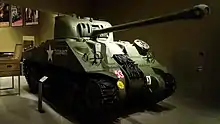
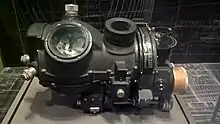

The Kwadrat architectural team won an architectural competition for the building of the Museum of the Second World War.[2]
History
The museum was created on 1 September 2008 by way of a regulation of the Minister of Culture and National Heritage under the name Westerplatte Museum in Gdańsk. On the same day, Prime Minister Donald Tusk appointed prof. dr hab. Paweł Machcewicz as his representative for the Museum of the Second World War. The team of the representative for the museum included dr hab. Piotr M. Majewski - historian from the Warsaw University and dr Janusz Marszalec, who was the head of the Public Education Department Office of the Institute of National Remembrance in Gdańsk from 2000 to 2007. The purpose of the team included i.e. the development of a Museum of the Second World War programme concept. The concept has been presented to the public on 6 October 2008 at the Chancellery of the President of the Council of Ministers in Warsaw during a discussion with historians and museologists. The text of the concept and record of the discussion have been published in print,[3] and is also accessible directly via the museum's website.[4] Development of the concept and contents of the exhibitions were co-created by renowned scholars of WWII and totalitarianism, including: Norman Davies, Timothy Snyder, Tomasz Szarota, Włodzimierz Borodziej and Jerzy Wojciech Borejsza.[5]
On 26 November 2008, the Minister of Culture and National Heritage, Mr Bogdan Zdrojewski changed the name of this institution from the Westerplatte Museum to the Museum of the Second World War in Gdansk.[6] At the same time, he defined the scope of tasks of the facility stating: “the object of the museum’s operations is to amass a collection pertaining to the history of World War II, safeguard it, and make it available, in particular by means of exhibition, popularisation, education, and publishing”.[6]
On 15 April 2016, the Minister of Culture and National Heritage, Mr Piotr Gliński informed about combining the Museum of the Second World War and the Museum of Westerplatte and the War of 1939 (being organised), created in 2015.[7] Mr Gliński's decision was influenced by the negative reviews of the Main Exhibit of the museum ordered by the ministry and penned by Jan Żaryn, Piotr Semka and Piotr Niwiński.[8][9]
At the end of 2016, the Voivodeship Administrative Court in Gdańsk questioned the decision of the minister of culture about combining the two and ordered works to that effect to be halted until the case is examined. The Ministry of Culture deemed the court's decision as invalid.[10] In January 2017, the Supreme Administrative Court overruled the Voivodeship Administrative Court's decision.[11]
On 30 January 2017, the Voivodeship administrative court in Warsaw halted the combining of the two museums until a lawful examination of the complaint filed by the museum's management and the Commissioner for Human Rights. On March 23, the museum was opened for the public.[12] On April 5, the Supreme Voivodeship Court finally overruled the motion to suspend execution of the regulation of the Minister of Culture and National Heritage. On April 6, Dr Karol Nawrocki was appointed as acting director of the combined facilities.[13]
In September 2019, a statue of Witold Pilecki was erected in front of the museum, showing the cavalry captain in his uniform and a camp cap in hand. The piece's designer was Mr Maciej Jagodziński-Jagennmerr, and the casting and erection cost PLN 400,000.[14]
Building
The Prime Minister of Poland, Donald Tusk, opened the architectural competition to design the main building of the museum. The judging panel included such experts as Daniel Liebeskind and Jack Lohman, the director of the Museum of London. The winning design was created by the Gdynia-based Kwadrat architectural studio. The seat of the museum faces the Motława River and is located on Wałowa Street in close proximity to the Radunia Canal and the historical Polish Post Office Building. The museum grounds cover an area of 2.5 acres and the building itself covers approximately 23,000 square metres. The building consists of three major spheres, which symbolically represent the connection between the past, present and future. The most distinctive part of the building is the 40-metre tall leaning tower with a glass façade, which houses a library, reading and conference rooms as well as cafés and restaurants with a view of the panorama of Gdańsk.[15][16]
Management
Dr Karol Nawrocki is the museum's director. Prof. dr hab Grzegorz Berendt and Dr Tomasz Szturo are his deputies. Prof. Dr hab. Paweł Machcewicz was the museum's director until April 5, 2017, and Dr Janusz Marszalec and Dr hab. Piotr M. Majewski served as his deputies.
On 7 February 2018, the Minister of Culture and National Heritage and Deputy Prime Minister Piotr Gliński appointed new members of the museum's management board, which include: Sławomir Cenckiewicz, Marek Jan Chodakiewicz, Jacek Friedrich, Mirosław Golon, Piotr M. Majewski, Bogdan Musiał, Piotr Niwiński, Andrzej Nowak, Piotr Semka, Zbigniew Wawer, Jarosław Wąsowicz, Tadeusz Wolsza, Jan Żaryn.[17]
Reception
The museum has been criticized for what is seen as excessive meddling by the ruling Law and Justice party. The new exhibits placed a high emphasis on the victimization of ethnic Poles during the war.[18][19][20] Several of the original authors filed a lawsuit for copyright infringement when the exhibits were changed without consultation, which they won in October 2020.[21]
In December 2017, a group of five hundred academics signed an open letter that called the changes to the museum "barbaric" and part of an attempt to turn it into a "propaganda institution," while a government spokesperson defended the changes, saying the exhibits needed to be "corrected" and adding that "Some things need to be rearranged, which happens at all museums in the world. But it is also a Polish museum financed by Polish taxpayers. Polish people simply want the museum they have financed to tell their story, to refer to the Polish point of view. The museum is located in Poland and must answer to those who financed it."[22]
Gallery
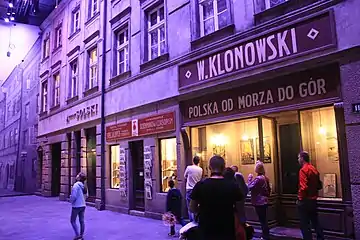 Polish city street, 1930s
Polish city street, 1930s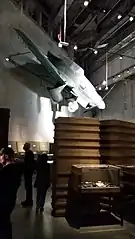 German Junkers Ju 87 "Stuka" at permanent exhibition
German Junkers Ju 87 "Stuka" at permanent exhibition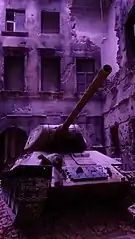 Soviet T-34 Tank inside
Soviet T-34 Tank inside Enigma machine cipher machine
Enigma machine cipher machine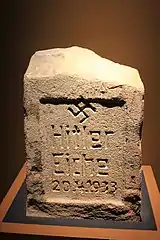 A stone from Krępa Kaszubska marking an oak tree planted to celebrate the birth of Adolf Hitler https://de.wikipedia.org/wiki/Hitler-Eiche
A stone from Krępa Kaszubska marking an oak tree planted to celebrate the birth of Adolf Hitler https://de.wikipedia.org/wiki/Hitler-Eiche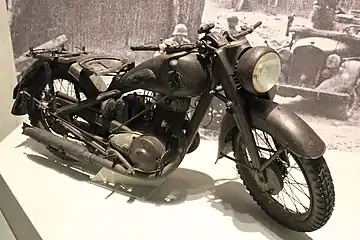 DKW motorcycle
DKW motorcycle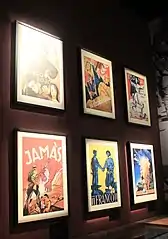 Spanish nationalist posters
Spanish nationalist posters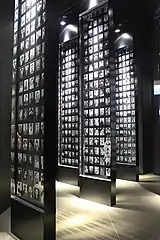 Photographs of Holocaust victims
Photographs of Holocaust victims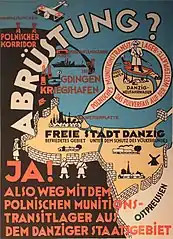 German propaganda poster
German propaganda poster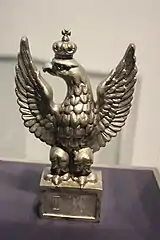 Eagle from the banner of the First Polish Corps
Eagle from the banner of the First Polish Corps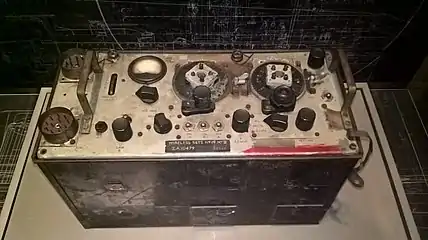
.jpg.webp) Joseph Stalin's pipe
Joseph Stalin's pipe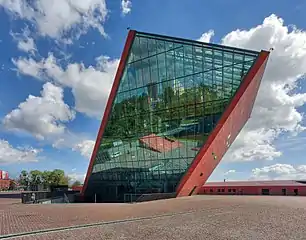 Exterior of the museum
Exterior of the museum
See also
References
- "3. Muzeum II Wojny Światowej: 413 812 zwiedzających". Retrieved 2018-09-02.
- "Czerwona wieża nad Gdańskiem". Rzeczpospolita. 2 September 2010. Retrieved 25 September 2011.
- „Przegląd Polityczny” nr 91/92, 2008
- "Materiały do pobrania « Media « Muzeum II Wojny Światowej". muzeum1939.pl. Retrieved 2015-12-21.
- a,78475#.WSHitVP8v6w.facebook "MIIWŚ. Nowy dyrektor zapowiada rychłe zmiany na wystawie". gdansk.pl. Retrieved 2017-05-21.
{{cite web}}: Check|url=value (help) - "Zarządzenie nr 41 Ministra Kultury i Dziedzictwa Narodowego z dnia 26 listopada 2008 r. zmieniające zarządzenie w sprawie utworzenia Muzeum Westerplatte w Gdańsku" (PDF). bip.mkidn.gov.pl. Retrieved 2015-12-21.
- "Obwieszczenie Ministra Kultury i Dziedzictwa Narodowego z dnia 15 kwietnia 2016 r. o zamiarze i przyczynach połączenia państwowych instytucji kultury Muzeum II Wojny Światowej w Gdańsku oraz Muzeum Westerplatte i Wojny 1939" (PDF). bip.mkidn.gov.pl. Retrieved 2016-04-16.
- Orzechowski, Hubert (2016-07-15). wojny-swiatowej recenzje,artykuly,391987,1.html ""Niewiele wspólnego z wiedzą historyczną". Muzeum II Wojny Światowej odpowiada recenzentom Glińskiego" (in Polish). Retrieved 2018-01-29.
{{cite web}}: Check|url=value (help) - Zalesinski, Jarosław (2015-06-30). "Krytyczne recenzje programu wystawy głównej Muzeum II Wojny Światowej" (in Polish). Retrieved 2018-01-29.
- "Konflikt wokół MIIWŚ: prof. Machcewicz usunięty z debaty historyków na polecenie ministra?". www.gdansk.pl. Retrieved 2017-01-16.
- "Postanowienie NSA w sprawie wstrzymania wykonania zarządzenia Ministra Kultury dotyczącego połączenia Muzeum II Wojny Światowej w Gdańsku i Muzeum Westerplatte i Wojny 1939". Naczelny Sąd Administracyjny -Komunikaty. 2017-01-24. Retrieved 2017-01-27.
- "Aktualności". muzeum1939.pl. 2017-03-24. Retrieved 2017-03-26.
- "Dr Karol Nawrocki nowym dyrektorem Muzeum II Wojny Światowej". Onet Trójmiasto (in Polish). 2017-04-06. Retrieved 2017-04-06.
- Pomnik rotmistrza Pileckiego stanie przed Muzeum II Wojny Światowej
- "Museum of the Second World War". Retrieved 2018-09-02.
- "Museum of the Second World War / Studio Architektoniczne Kwadrat". Retrieved 2018-09-03.
- "Minister Kultury powołał członków Rady Muzeum". Retrieved 2018-09-03.
- "TVP nadaje na twórców Muzeum II Wojny Światowej. Seans bzdur i oszczerstw". oko.press. Retrieved 15 October 2020.
- Ciobanu, Claudia (15 May 2017). "Poland's WWII museum under political bombardment". POLITICO. Retrieved 15 October 2020.
- Hackmann, Jörg (2 October 2018). "Defending the "Good Name" of the Polish Nation: Politics of History as a Battlefield in Poland, 2015–18". Journal of Genocide Research. 20 (4): 587–606. doi:10.1080/14623528.2018.1528742.
- "Wyrok w procesie o wystawę w Muzeum II Wojny Światowej". oko.press. Retrieved 15 October 2020.
- "Outcry over Polish government's changes to Second World War museum". The Art Newspaper - International art news and events. 2017-12-21. Retrieved 2022-05-04.
Further reading
- Hackmann, Jörg (2018). "Defending the "Good Name" of the Polish Nation: Politics of History as a Battlefield in Poland, 2015–18". Journal of Genocide Research. 20 (4): 587–606. doi:10.1080/14623528.2018.1528742. S2CID 81922100.
- Clarke, David; Duber, Paweł (2020). "Polish Cultural Diplomacy and Historical Memory: the Case of the Museum of the Second World War in Gdańsk". International Journal of Politics, Culture, and Society. 33 (1): 49–66. doi:10.1007/s10767-018-9294-x. ISSN 1573-3416. S2CID 53073981.